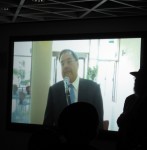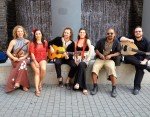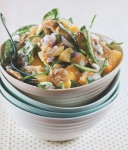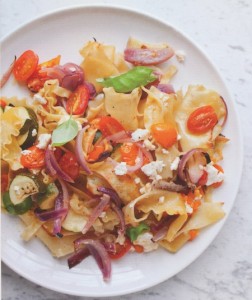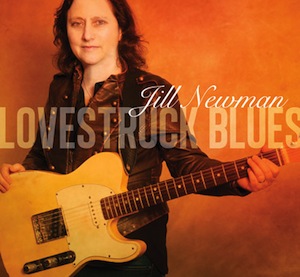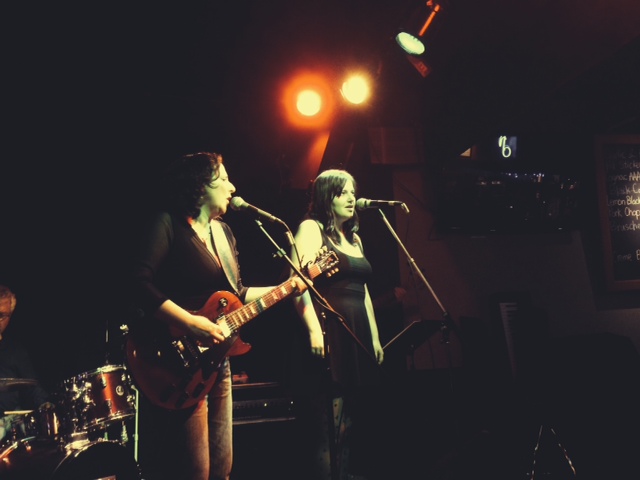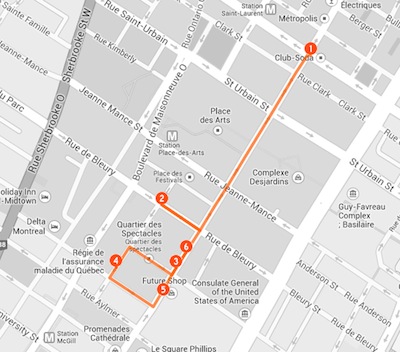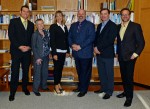Rabbi Shlomo Riskin speaks to the Vancouver audience via webcast. (photo by Cynthia Ramsay)
Empowerment. Scholarship. Connection. Each of these words was used more than once to describe the Rebbe – Rabbi Menachem Mendel Schneerson, z”l – and his impact during the July 9 community commemoration of the 20th year since his passing.
At Chabad Lubavitch at Oak and 41st, the six B.C. Chabad Houses hosted a night of learning, with workshops and dinner, followed by a speech, via webcast, from Rabbi Shlomo Riskin, chief rabbi of Efrat, Israel, and chancellor of Ohr Torah Stone in Israel, and the video The Rebbe: Marching Orders.
Timeless Leadership: An Evening of Inspiration offered two sets of workshops from which attendees could choose. The first set comprised Turning Lubavitch Outward by Rabbi Yitzchok Wineberg of Chabad Lubavitch BC; The Rebbe’s Melodies by Rabbi Falik Schtroks of the Centre for Judaism in White Rock; and Stories of the Rebbe by Rabbi Yechiel Baitelman of Chabad of Richmond. The second set was The Wisdom of the Lubavitcher Rebbe by Rabbi Binyomin Bitton of Chabad of Downtown, and The Rebbe’s Advice by Rabbi Dovid Rosenfeld of Camp Gan Israel; Rabbi Meir Kaplan of Chabad of Vancouver Island, was unable to attend.
Among the handouts was a timeline of Schneerson’s life prior to his becoming the Rebbe. Born in Ukraine in 1902, Schneerson was considered a child prodigy and, by the time he was in his teens, he was exchanging letters with respected scholars. He married Chaya Mushka, the daughter of the sixth Lubavitcher Rebbe, Rabbi Yosef Yitzchak Schneersohn, in Poland in 1928. He then went to the University of Berlin, followed by the ESTL engineering school and the Sorbonne in Paris, while also giving Torah classes and the like. When the Nazis conquered Paris, the Rebbe and his wife managed to escape, by ship from Lisbon to New York. At his father-in-law’s behest, Schneerson became a director of multiple Lubavitch organizations and began to publish his thoughts on Chassidic tracts and write responsa. In 1951, a year after his father-in-law died, Schneerson became the Rebbe.
Wineberg, who gave a brief overview of Chabad’s history, called Schneerson “a Rebbe for our times.” A more critical problem in our age – the last 65, and especially the last 30-35, years – than assimilation, said Wineberg, has been low self-esteem. In this context, he highlighted the Rebbe’s belief that, “There is no such thing as a small Jew.” The Rebbe took what was an insular, study-focused organization and, while keeping the foundation of Torah and study, broadened its vision to include all Jews, said Wineberg, noting that the Rebbe connected with every single person he encountered. The Rebbe, he said, was the inspiration behind Chabad heading to campuses, to welcoming Jews to dinner, to prayer, to don tefillin.
Bitton provided some statistics on the Rebbe’s outreach and his scholarly contributions: he spoke on 31,393 occasions, for example, and 11,700 of his letters have been published so far; there are tens of thousands of pages of his writings. The Rebbe’s unique approach to learning, explained Bitton, is that he connected talmudic understanding with its kabbalistic translation. When the Rebbe analyzed an idea, said Bitton, he peeled its exterior layers away and got to the pure essence of the idea, the quintessential idea that was at the root of the discussion. For the Rebbe, he said, kol haTorah inyan echad, the entire Torah is one “topic.”
In telling the stories of his encounters with the Rebbe, Riskin echoed some of the sentiments shared by the local Chabad rabbis in their presentations. He compared the Rebbe to Moses, in that, as Moses is still alive in a sense because his teachings continue to be studied, the same is true of the Rebbe. “Certainly for me,” said Riskin, “because not only did he change my life, but he gave me fundamental messages by which I live my life, and which informed my world of education … and my world of the rabbinate.”
Riskin shared how he became the founding rabbi of Lincoln Square Synagogue in the mid-1960s. Having attended Yeshivah University on scholarships, he wanted to repay the institution and agreed to do some speaking engagements after receiving his ordination, one of which was at “a kind of Rosh Hashanah-Yom Kippur synagogue” that didn’t have its own building and was in what was then a poor neighborhood. They had a rabbi and were relatively satisfied but not completely, so they approached YU and, after Riskin came for one Motzei Shabbat, they wanted to hire him. When deciding whether or not to accept the pulpit, Riskin was conflicted and received conflicting advice. So, he asked for a meeting with the Rebbe, who told him to listen to his own rebbe (Rav Joseph B. Soloveitchik, z”l), adding that, “In every battle, there are people who have to get dressed like the enemy and go into the enemy territory … and you will not only win the battle, you will win the war.”
When Riskin argued that his future congregants have no background and that he would have nothing with which to work, the Rebbe said, “You can never say about a Jew that he has no background. Every Jew has a kingly background; every Jew is, after all, a descendant of Avraham, Yitzchak, Yaakov, of Sarah, Rivka, Rachel and Leah…. I left the Rebbe’s presence awestruck, and with a very profound sense of empowerment.”
Another encounter with the Rebbe took place after Riskin had spent time working with an eccentric, wealthy man who, when he met Riskin was non-observant and married to a non-Jew. After that initial meeting, Riskin accepted the man as a single member of the shul (i.e. without his wife) but later found himself doubting that decision. When he asked the Rebbe about it, the Rebbe never told Riskin whether he’d made the right decision, but rather said, “No one is able to truly evaluate the profound value of the Jewish soul.” This meant, said Riskin, that “every Jew has an affinity to Torah and you can never give up on any Jew no matter how far away he may have went. And that, too, has become a very important part of my teaching.”
When Riskin was making aliyah, he could not meet with the Rebbe directly – because of the Rebbe’s ill health following a heart attack – but he received his blessing through Soloveitchik at a farbrengen (Chassidic gathering) they were all attending. To the blessing, the Rebbe added that, in Efrat, Riskin “must produce shluchim, emissaries, who are modern on the outside and Chabad on the inside.” Riskin credits the Rebbe for his having been able to establish Ohr Torah Stone, which has, among other programs, hundreds of shluchim.

